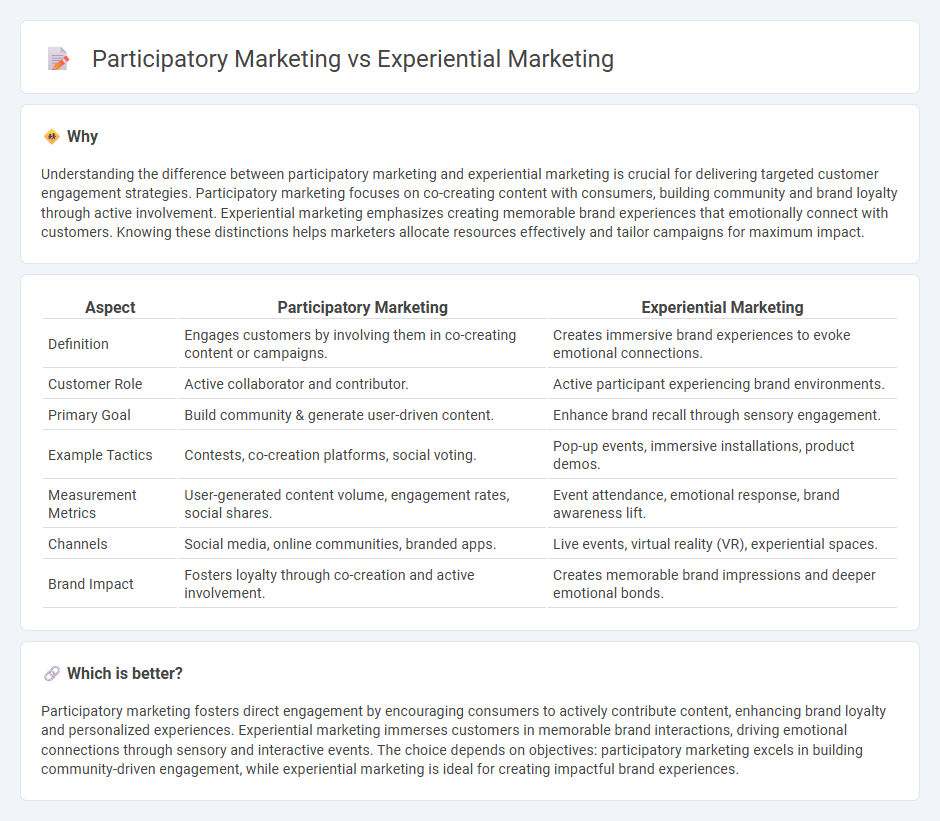
Participatory marketing engages consumers by involving them directly in brand campaigns, fostering a sense of ownership and community around the product. Experiential marketing creates immersive brand experiences that evoke emotions and memorable interactions, enhancing customer loyalty and brand recall. Explore more to understand how these dynamic strategies can transform your marketing approach.
Why it is important
Understanding the difference between participatory marketing and experiential marketing is crucial for delivering targeted customer engagement strategies. Participatory marketing focuses on co-creating content with consumers, building community and brand loyalty through active involvement. Experiential marketing emphasizes creating memorable brand experiences that emotionally connect with customers. Knowing these distinctions helps marketers allocate resources effectively and tailor campaigns for maximum impact.
Comparison Table
| Aspect | Participatory Marketing | Experiential Marketing |
|---|---|---|
| Definition | Engages customers by involving them in co-creating content or campaigns. | Creates immersive brand experiences to evoke emotional connections. |
| Customer Role | Active collaborator and contributor. | Active participant experiencing brand environments. |
| Primary Goal | Build community & generate user-driven content. | Enhance brand recall through sensory engagement. |
| Example Tactics | Contests, co-creation platforms, social voting. | Pop-up events, immersive installations, product demos. |
| Measurement Metrics | User-generated content volume, engagement rates, social shares. | Event attendance, emotional response, brand awareness lift. |
| Channels | Social media, online communities, branded apps. | Live events, virtual reality (VR), experiential spaces. |
| Brand Impact | Fosters loyalty through co-creation and active involvement. | Creates memorable brand impressions and deeper emotional bonds. |
Which is better?
Participatory marketing fosters direct engagement by encouraging consumers to actively contribute content, enhancing brand loyalty and personalized experiences. Experiential marketing immerses customers in memorable brand interactions, driving emotional connections through sensory and interactive events. The choice depends on objectives: participatory marketing excels in building community-driven engagement, while experiential marketing is ideal for creating impactful brand experiences.
Connection
Participatory marketing engages consumers by encouraging their active involvement in brand-related experiences, creating a sense of ownership and loyalty. Experiential marketing offers immersive, memorable events that stimulate emotional connections between the consumer and the brand. Both strategies emphasize consumer interaction and personalized experiences, driving deeper engagement and stronger brand relationships.
Key Terms
**Experiential Marketing:**
Experiential marketing immerses consumers in interactive brand engagements designed to create memorable emotional connections and stimulate all five senses, enhancing brand recall and loyalty. This strategy leverages events, activations, and sensory experiences to engage audiences more deeply than traditional advertising. Explore how experiential marketing can transform your brand engagement strategies for lasting impact.
Brand Immersion
Experiential marketing creates immersive brand experiences that engage consumers' senses and emotions, fostering a deep connection through memorable events or activations. Participatory marketing invites consumers to actively contribute to the brand narrative, encouraging user-generated content and co-creation that strengthens personal investment and community engagement. Explore how these dynamic strategies enhance brand immersion and drive meaningful customer relationships.
Sensory Engagement
Experiential marketing immerses consumers through multi-sensory environments that evoke emotional connections by engaging sight, sound, touch, taste, and smell. Participatory marketing goes beyond by actively involving audiences in co-creating brand experiences, fostering deeper personal investment and interaction. Explore further to discover how sensory engagement strategies transform consumer-brand relationships.
Source and External Links
Experiential Marketing: A Guide - Salesforce - Experiential marketing creates memorable, immersive brand experiences that engage customers deeply through interactive events and activities, going beyond traditional ads to form emotional connections and expand brand reach.
What is experiential marketing? Definition and examples - Amazon Advertising - Experiential marketing connects consumers with brands through unique, often in-person experiences like pop-ups and virtual events, designed to create surprise, delight, and meaningful engagement measurable by various metrics.
What is experiential marketing: Definition, why it works & examples - Xola - Experiential marketing builds authentic emotional engagement and enhances brand perception by offering memorable, sensory experiences that increase customer interaction, drive word-of-mouth, and improve return on investment.
 dowidth.com
dowidth.com